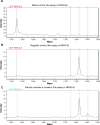Oncogene mutational profile in nasopharyngeal carcinoma
- PMID: 24672248
- PMCID: PMC3964172
- DOI: 10.2147/OTT.S58791
Oncogene mutational profile in nasopharyngeal carcinoma
Abstract
Nasopharyngeal carcinoma (NPC) is a common tumor in Southern China, but the oncogene mutational status of NPC patients has not been clarified. Using time-of-flight mass spectrometry, 238 mutation hotspots in 19 oncogenes were examined in 123 NPC patients. The relationships between mutational status and clinical data were assessed with a χ(2) or Fisher's exact test. Survival analysis was performed using the Kaplan-Meier method with the log-rank test. In 123 patients, 21 (17.1%) NPC tumors were positive for mutations in eight oncogenes: six patients had PIK3CA mutations (4.9%), five NRAS mutations (4.1%), four KIT mutations (3.3%), two PDGFRA mutations (1.6%), two ABL mutations (1.6%), and one with simultaneous mutations in HRAS, EGFR, and BRAF (1%). Patients with mutations were more likely to relapse or develop metastasis than those with wild-type alleles (P=0.019). No differences or correlations were found in other clinical characteristics or in patient survival. No mutations were detected in oncogenes AKT1, AKT2, CDK, ERBB2, FGFR1, FGFR3, FLT3, JAK2, KRAS, MET, and RET. These results demonstrate an association between NPC and mutations in NRAS, KIT, PIK3CA, PDGFRA, and ABL, which are associated with patient relapse and metastasis.
Keywords: NPC; mutation; oncogene.
Figures


Similar articles
-
Concurrent oncogene mutation profile in Chinese patients with stage Ib lung adenocarcinoma.Medicine (Baltimore). 2014 Dec;93(29):e296. doi: 10.1097/MD.0000000000000296. Medicine (Baltimore). 2014. PMID: 25546673 Free PMC article.
-
Oncogene mutational analysis in Chinese gastrointestinal stromal tumor patients.Onco Targets Ther. 2018 Apr 20;11:2279-2286. doi: 10.2147/OTT.S155214. eCollection 2018. Onco Targets Ther. 2018. PMID: 29719410 Free PMC article.
-
Molecular diagnostic characteristics based on the next generation sequencing in lung cancer and its relationship with the expression of PD-L1.Pathol Res Pract. 2020 Feb;216(2):152797. doi: 10.1016/j.prp.2019.152797. Epub 2019 Dec 23. Pathol Res Pract. 2020. PMID: 31926773
-
Mutational screening of RET, HRAS, KRAS, NRAS, BRAF, AKT1, and CTNNB1 in medullary thyroid carcinoma.Anticancer Res. 2011 Dec;31(12):4179-83. Anticancer Res. 2011. PMID: 22199277
-
Hotspot mutations in common oncogenes are infrequent in nasopharyngeal carcinoma.Oncol Rep. 2014 Oct;32(4):1661-9. doi: 10.3892/or.2014.3376. Epub 2014 Aug 1. Oncol Rep. 2014. PMID: 25109408
Cited by
-
Mutation profiling in chinese patients with metastatic colorectal cancer and its correlation with clinicopathological features and anti-EGFR treatment response.Oncotarget. 2016 May 10;7(19):28356-68. doi: 10.18632/oncotarget.8541. Oncotarget. 2016. PMID: 27050078 Free PMC article.
-
A retrospective paired study: efficacy and toxicity of nimotuzumab versus cisplatin concurrent with radiotherapy in nasopharyngeal carcinoma.BMC Cancer. 2016 Dec 13;16(1):946. doi: 10.1186/s12885-016-2974-x. BMC Cancer. 2016. PMID: 27955638 Free PMC article.
-
Nutlin-3 sensitizes nasopharyngeal carcinoma cells to cisplatin-induced cytotoxicity.Oncol Rep. 2015 Oct;34(4):1692-700. doi: 10.3892/or.2015.4177. Epub 2015 Aug 5. Oncol Rep. 2015. PMID: 26252575 Free PMC article.
-
MiRNA-145 Induces Apoptosis in a Gallbladder Carcinoma Cell Line by Targeting DFF45.Open Life Sci. 2018 Jul 5;13:227-235. doi: 10.1515/biol-2018-0027. eCollection 2018 Jan. Open Life Sci. 2018. PMID: 33817087 Free PMC article.
-
Clinical genetic features and related survival implications in patients with surgically resected large-cell lung cancer.Cancer Manag Res. 2019 Jun 14;11:5489-5499. doi: 10.2147/CMAR.S200263. eCollection 2019. Cancer Manag Res. 2019. PMID: 31354355 Free PMC article.
References
-
- Wei WI, Sham JS. Nasopharyngeal carcinoma. Lancet. 2005;365(9476):2041–2054. - PubMed
-
- McDermott AL, Dutt SN, Watkinson JC. The aetiology of nasopharyngeal carcinoma. Clin Otolaryngol Allied Sci. 2001;26(2):82–92. - PubMed
-
- Chua DT, Ma J, Sham JS, et al. Long-term survival after cisplatin-based induction chemotherapy and radiotherapy for nasopharyngeal carcinoma: a pooled data analysis of two phase III trials. J Clin Oncol. 2005;23(6):1118–1124. - PubMed
LinkOut - more resources
Full Text Sources
Other Literature Sources
Research Materials
Miscellaneous

